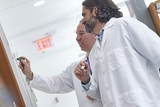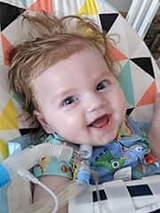Lung Transplant: Leah’s Story
Lung Transplant: Leah’s Story
When Lisa went into labor in October 2020, she and her husband, Lou, had no reason to think anything would be wrong with the baby. But when their daughter Leah was born at a Bucks County, Pa., hospital, she immediately had trouble breathing. The next four months were spent trying to fix Leah’s lung problem and increase the oxygen level in her blood.

After Leah was born, an echocardiogram showed she had severe pulmonary hypertension. At two days old, she was transferred to Children's Hospital of Philadelphia (CHOP) and was put on a ventilator, sedated, in the Harriet and Ronald Lassin Newborn/Infant Intensive Care Unit (N/IICU). “We were hoping her oxygen levels would improve and we’d be home in two weeks,” says Lisa. “But after a week there wasn’t much change.”
The pulmonary team was consulted for their expertise. The pulmonologists suspected that Leah’s pulmonary hypertension could be caused by inherited lung disease, so around Halloween she had genetic testing performed and a lung biopsy. When the results of the genetic test came back a month later, they showed genetic mutations consistent with a condition called surfactant protein deficiency, a rare lung disorder in infants. The only curative treatment is a lung transplant. In early December, Leah was listed on the national registry for a lung transplant. “We began the waiting game,” says Lisa — but the wait would not be uneventful.
Since Leah was no longer a newborn, she was transferred to CHOP’s Pediatric Intensive Care Unit (PICU). Initially, her oxygen levels dropped, but then she stabilized. It was decided to do a tracheotomy and insert a feeding tube. “Everything was OK for about a month,” says Lisa. “But then she spiraled down again.” At this point, Lisa and Lou faced a harrowing decision: either attach Leah to a machine that pumps and oxygenates her blood or put her on hospice care.

Life-saving solutions, supported by donors
Your gift funds innovative interventions that improve survival rates for critically ill children like Leah.
From heart-lung bypass machine to lung transplant
“I thought we needed to try everything,” says Lou. “I wouldn’t want to later wonder ‘what if?’” So they decided to use the heart-lung bypass machine, called ECMO, which stands for extracorporeal membrane oxygenation.
The surgery was performed by Katsuhide Maeda, MD, PhD, the Director of Mechanical Circulatory Support and ECMO and the Surgical Director of CHOP's Lung and Heart Transplant Programs. The surgery represented an innovation for ECMO in such a small child. “The way that I placed her on ECMO was unique and relatively new in that the machine’s tubes were inserted directly through the chest,” explains Dr. Maeda.
The surgery was successful, but now Lisa and Lou faced a new reality. “Dr. Maeda and the PICU team had walked us through what the surgery would look like and what she would look like,” explains Lisa. “But afterward, it was really hard seeing all those tubes and the big machine and knowing there was no going back.”
Just a few days later, Lisa received a call from Maureen Josephson, DO, Medical Director of the Lung Transplant Program. Lisa assumed that Dr. Josephson was checking in on how they were holding up, but instead she was calling with news: A donor had been found. “I ran through the house screaming,” says Lisa.
A totally different kid

The lung transplant was also performed by Dr. Maeda. “We were really happy about that, since he knew her physiology from the first surgery,” says Lisa. “Afterward, he told us it could not have gone better.”
“She is the youngest survivor at CHOP to go from ECMO to a double lung transplant, and possibly one of the youngest in the U.S.,” says Dr. Maeda.
As the weeks passed and Leah was progressively weaned from her medications, “She was a totally different kid,” says Lisa. “She was all smiles.”
Lisa and Lou praise the care they received at CHOP. “The pulmonologists, the transplant team — all the doctors listened to all our questions and included us in decisions,” says Lisa. “I can’t say enough good things.” Leah is now at a rehabilitation facility, and Lisa and Lou are learning how to take care of her once she’s home — which will be an amazing step after many uncertain months.